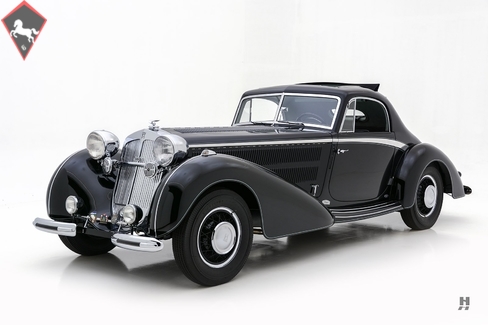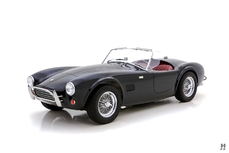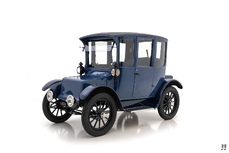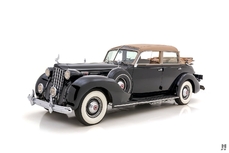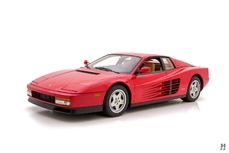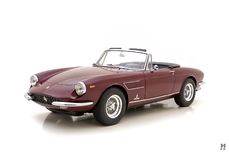Horch 851/853/853A/855/951/951A Coupe 1937
Allmän beskrivning :
Once part of the mighty Auto Union combine, Horch is one of the German motoring industry's proudest pre-war marques. Founded in 1900 by August Horch, the firm steadily grew its reputation for engineering excellence and became a leading competitor to Daimler and Mercedes through the 1920s and 1930s, joining Audi, DKW, and Wanderer to form Auto Union in 1932. In the middle of the 1930s, the Auto Union Grand Prix team was locked in a fierce battle with Mercedes-Benz for supremacy on European racing tracks. The Germans saw motor racing as the ideal showcase for their engineering might, and threw seemingly endless resources behind their national teams, creating one of the greatest eras of technical advancement in the history of motorsport.
As the power and speed of the cars grew exponentially, drivers became national heroes. Auto Union's star was the great Bernd Rosemeyer, who famously man-handled the fearsome mid-engine Silver Arrows (with upwards of 550 horsepower!) to victory in numerous races across Germany and the rest of Europe. He won the German, Swiss, and Italian Grands Prix to take the European Championship in 1936, and claimed four of the five Auto Union victories against Mercedes-Benz's formidable new W125 in 1937. He became an international superstar after winning the Vanderbilt Cup in 1937 and is still counted as one of the greatest racing drivers of all time.
For their star driver, Auto Union commissioned a spectacular automobile as a reward for Rosemeyer's achievements. Based upon a special shortened, 130-inch chassis from the flagship Horch 853, the car wore a stunning one-off streamlined coupe body, designed by Johannes Beeskow and built by Erdmann & Rossi. The coachwork featured the curvaceous and graceful pontoon fenders of the Spezialroadsters, combined with a unique flowing fixed-head roofline and well-judged chrome accents. Rosemeyer nicknamed the car "Manuela," and he regularly as his transport to racing events and even the occasional Concours d'Elegance alongside his wife Elly Beinhorn; herself an accomplished pilot.
Sadly, Rosemeyer didn't get to enjoy Manuela for very long, as his life was tragically cut short in a record-breaking attempt on a stretch of the newly completed Autobahn. While attempting to beat a personal record of 268 mph, his Auto Union streamliner caught a crosswind, resulting in a spectacular crash. The 28-year-old Rosemeyer was thrown from the car and killed. The fate of Manuela is shrouded in mystery, as the Horch disappeared from public view shortly after Rosemeyer's death and was never seen again. Theories suggest it was either broken up by the factory or sacrificed to the impending war effort. Thankfully, photos and documentation of the original car provided enough information for the creation of a small number of faithful homages to the original, including one displayed in the Audi AG museum.
Proudly offered here is a stunning and faithful tribute to Bernd Rosemeyer's famous "Manuela" Horch 853, artfully constructed by Horch-Classic of Germany. The original Horch 853 donor chassis was discovered a barn in Belarus, minus its coachwork. Per the original specification, Horch-Classic shortened the frame to 130-inches before restoring it to full running order. For the coachwork, Horch-Classic used images of the original car to create a wood body frame. Then Horch-Classic skinned the wood frame in steel panels. The attention to detail is impressive, including the louvered bonnet, swiveling side windows, and a rare Gülde fabric sunroof – acquired after an exhaustive search. The car was then finished in black and accented with pale coach stripes and a dramatic polished sweep. Other fittings include genuine Horch headlamp lenses, Bosch driving lamps, twin chrome Bosch horns, and semaphore turning indicators built into the body. The resulting car has a tremendous presence and is faithful to the original while seamlessly incorporating personal touches by the builders.
With the coachwork underway, the chassis was fully restored, including the independent front end and De Dion rear axle. The engine completely rebuilt with new pistons, bearings, and overhauled cam and valvetrain. The rotating assembly and flywheel were balanced to ensure refined, silky-smooth high-speed operation. The engine was then fully detailed with faithfully reproduced hardware, plumbing, and woven-fabric wiring loom. This car features the highly-desirable five-speed gearbox for superb high-speed touring performance.
Black leather upholstery with contrasting piping provides a lovely complement to the paintwork. The upholstered instrument panel gives this Horch a businesslike, sporting appeal. As with the coachwork, the soft trim is beautiful, finished to a high standard and presented in taut, fresh condition. Authentic fittings, instruments, and hardware complete the package, and a set of period-correct fitted luggage behind the seats provide a charming flourish to the cabin.
Rosemeyer's "Manuela" may be lost to history, yet this superb recreation honors the spirit and style of the original, with impressive levels of craftsmanship. Superbly crafted and used sparingly since the restoration, this highly desirable German classic is prime for enjoyment in touring and road events worldwide.
Offers welcome and trades considered
https://hymanltd.com/vehicles/6558
1937 Horch 851/853/853A/855/951/951A Coupe is listed såld on ClassicDigest in St. Louis by Mark Hyman for $575000.
Fakta i bilen
Karosstyp : Personbil Märke : Horch Modell : 851/853/853A/855/951/951A Modellversion : Coupe Motorvolym : 0.0 Årsmodell : 1937 Karosstyp : Coupé Läge : Missouri
Såld
Information om säljaren
Såld
Other cars listed for sale by this dealer
om Horch
Horch, den tyska tillverkaren av lyxbilar, hamnade ofta i skuggan av sina mer kända konkurrenter som Mercedes-Benz och BMW. Ändå hade företaget en unik och anmärkningsvärd historia inom lyxbilsvärlden.Horchs grundande:
Horch grundades 1904 av den visionära ingenjören August Horch. Företaget hade sitt säte i Zwickau, Tyskland, och fick snabbt rykte om sig att tillverka högkvalitativa, fint hantverkade bilar.
Rivalitet med Mercedes-Benz:
En av de största utmaningarna för Horch var den hårda konkurrensen med Mercedes-Benz, jätten inom tysk lyxbilsindustri. Mercedes-Benz var ett känt varumärke och dess bilar var synonymt med lyx och prestanda. Denna rivalitet satte ofta Horch i skuggan.
Ingenjörsmässig excellens:
Horch var dock inte sämre när det gäller ingenjörskonst. Företaget var ansvarigt för flera innovationer, inklusive införandet av en rak åttacylindrig motor. Dessa tekniska framsteg bidrog till att Horch fick erkännande för sin prestanda och pålitlighet.
Fusion med Auto Union:
År 1932 slogs Horch, tillsammans med Audi, DKW och Wanderer, samman för att bilda Auto Union. De fyra ihopkopplade ringarna i Audis logotyp symboliserade denna union. Under Auto Unions paraply fortsatte Horch att tillverka lyxbilar och bidrog till gruppens övergripande framgång.
Utmaningar och andra världskriget:
Andra världskriget medförde betydande störningar i Horchs produktion. Efterkrigstiden innebar även ekonomiska utmaningar när företaget försökte återfå sin förkrigsglans.
Vägens slut:
År 1958 köptes Auto Union av Daimler-Benz, moderföretaget till Mercedes-Benz. Detta markerade slutet för varumärket Horch. Dess arv inkorporerades i den större Auto Union-familjen.
Horch kanske inte nådde samma internationella berömmelse som Mercedes-Benz, men företaget spelade en betydande roll i historien om tyska lyxbilar. Dess engagemang för ingenjörsmässig excellens och lyx bidrog till det övergripande ryktet för tysk bilproduktion. Även om det hamnade i skuggan av sina konkurrenter, lever Horchs arv som ett vittnesbörd om den gyllene eran av fordonskonsthantverk i Tyskland. Det påminner oss om att bilhistorien inte bara handlar om de stora namnen, utan också om de osynliga hjältar som har lämnat sina egna outplånliga spår.
